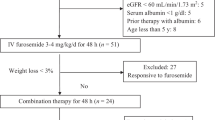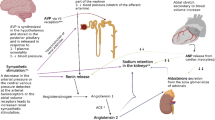Abstract
Tolvaptan (TLV) is a vasopressin V2 receptor antagonist that increases free water excretion. However, there are few reports of the use of TLV in pediatric patients with nephrotic syndrome (NS). The efficacy of TLV for the management of edema and hyponatremia in a 12-year-old boy with refractory NS is demonstrated. In this patient, refractory NS developed at 5 years of age, and remission was maintained with several immunosuppressive agents. He was admitted to hospital due to relapse with oliguria, edema, hypoalbuminemia, and hyponatremia. Infusion of human albumin and furosemide did not increase his urine volume, and hyponatremia worsened. Administration of TLV increased urine volume and improved his edema and hyponatremia. There were no adverse effects except for slow elevation of the serum sodium level. Serum osmolality increased gradually, and urine osmolality remained at low levels during TLV treatment. Additionally, a decrease in the sum of the urinary sodium and potassium concentrations was useful to predict the response to TLV and to assess the therapeutic effect of TLV as a biomarker for monitoring. TLV is effective for the management of fluid and electrolyte balance in pediatric NS patients. Early administration of TLV is considered a useful therapy for hyponatremia and refractory edema resistant to other diuretics.

Similar content being viewed by others
References
Nodari S, Jao GT, Chiong JR. Clinical utility of tolvaptan in the management of hyponatremia in heart failure patients. Int J Nephrol Renovasc Dis. 2010;3:51–60.
Konstam MA, Gheorghiade M, Burnett JC Jr, Grinfeld L, Maggioni AP, Swedberg K, Udelson JE, Zannad F, Cook T, Ouyang J, Zimmer C, Orlandi C. Effects of oral tolvaptan in patients hospitalized for worsening heart failure: the EVEREST outcome trial. JAMA. 2007;297:1319–31.
Sakaida I, Kawazoe S, Kajimura K, Saito T, Okuse C, Takaguchi K, Okada M, Okita K. Tolvaptan for improvement of hepatic edema: a phase 3, multicenter, randomized, double-blind, placebo-controlled trial. Hepatol Res. 2014;44:73–82.
Imamura T, Kinugawa K, Minatsuki S, Muraoka H, Kato N, Inaba T, Maki H, Hatano M, Yao A, Komuro I. Urine sodium excretion after tolvaptan administration is dependent upon baseline serum sodium levels: a possible explanation for the improvement of hyponatremia with scarce chance of hypernatremia by a vasopressin receptor antagonist. Int Heart J. 2014;55:131–7.
Shimizu M, Ishikawa S, Yachi Y, Muraoka M, Tasaki Y, Iwasaki H, Kuroda M, Ohta K, Yachie A. Tolvaptan therapy for massive edema in a patient with nephrotic syndrome. Pediatr Nephrol. 2014;29:915–7.
Meena J, Sinha A, Hari P, Bagga A. Therapy with the combination of tolvaptan and furosemide for refractory edema in nephrotic syndrome. Indian J Nephrol. 2020;30:53–5.
Usberti M, Federico S, Meccariello S, Cianciaruso B, Balletta M, Pecoraro C, Sacca L, Ungaro B, Pisanti N, Andreucci VE. Role of plasma vasopressin in the impairment of water excretion in nephrotic syndrome. Kidney Int. 1984;25:422–9.
Kapur G, Valentini RP, Imam AA, Mattoo TK. Treatment of severe edema in children with nephrotic syndrome with diuretics alone-a prospective study. Clin J Am Soc Nephrol. 2009;4:907–13.
Delbet JD, Parmentier C, Ulinski T. Tolvaptan therapy to treat severe hyponatremia in pediatric nephrotic syndrome. Pediatr Nephrol. 2020;35:1347–50.
Imamura T, Kinugawa K, Shiga T, Kato N, Muraoka H, Minatsuki S, Inaba T, Maki H, Hatano M, Yao A, Kyo S, Nagai R. Novel criteria of urine osmolality effectively predict response to tolvaptan in decompensated heart failure patient -association between non-responders and chronic kidney disease. Circ J. 2013;77:397–404.
Shoaf SE, Bricmont P, Mallikaarjun S. Pharmacokinetics and pharmacodynamics of oral tolvaptan in patients with varying degrees of renal function. Kidney Int. 2014;85:953–61.
Author information
Authors and Affiliations
Corresponding author
Ethics declarations
Conflict of interest
No author has a direct conflict of interest that is relevant to this study. Outside the contents of the study, Yoshitsugu Kaku received travel fees from CLS Behring.
Human and animal rights
This article does not contain any studies with human participants performed by any of the authors.
Informed consent
Informed consent was obtained from all individual participants included in the article.
Additional information
Publisher's Note
Springer Nature remains neutral with regard to jurisdictional claims in published maps and institutional affiliations.
About this article
Cite this article
Saimiya, M., Kaku, Y. & Nishimura, M. Efficacy of oral tolvaptan for severe edema and hyponatremia in a patient with refractory nephrotic syndrome. CEN Case Rep 10, 523–526 (2021). https://doi.org/10.1007/s13730-021-00601-1
Received:
Accepted:
Published:
Issue Date:
DOI: https://doi.org/10.1007/s13730-021-00601-1




